

Untitled. The Basics: A standard evidence table has 10 columns.
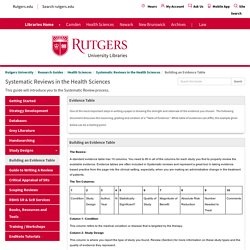
You need to fill in all of the columns for each study you find to properly review the available evidence. Evidence tables are often included in Systematic reviews and represent a great tool in taking evidence based practice from the page into the clinical setting, especially, when you are making an administrative change in the treatment of patients.
The Ten Columns: Column 1: Condition This column refers to the medical condition or disease that is targeted by the therapy. Column 2: Study Design This column is where you report the type of study you found. List one of the following Randomized controlled trial (RCT) Equivalence trial: An RCT which compares two active agents. Column 3: Author, Year. Untitled. A literature review is a survey of scholarly sources on a specific topic.
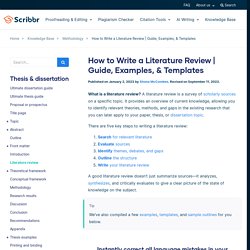
It provides an overview of current knowledge, allowing you to identify relevant theories, methods, and gaps in the existing research. Conducting a literature review involves collecting, evaluating and analyzing publications (such as books and journal articles) that relate to your research question. Untitled. Untitled. App b tables. Guidelines for writing a literature review.
"How to" Guideline series is coordinated by Helen Mongan-Rallis of the Education Department at the University of Minnesota Duluth.
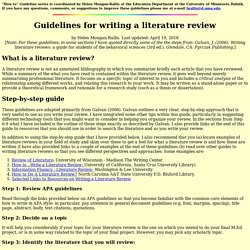
If you have any questions, comments, or suggestions to improve these guidelines please me at e-mail hrallis@d.umn.edu. by Helen Mongan-Rallis. Last updated: April 19, 2018 [Note: For these guidelines, in some sections I have quoted directly some of the the steps from: Galvan, J. (2006). Writing a Literature Review. Definition A literature review is both a summary and explanation of the complete and current state of knowledge on a limited topic as found in academic books and journal articles.
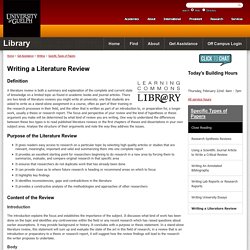
There are two kinds of literature reviews you might write at university: one that students are asked to write as a stand-alone assignment in a course, often as part of their training in the research processes in their field, and the other that is written as part of an introduction to, or preparation for, a longer work, usually a thesis or research report.
The focus and perspective of your review and the kind of hypothesis or thesis argument you make will be determined by what kind of review you are writing. One way to understand the differences between these two types is to read published literature reviews or the first chapters of theses and dissertations in your own subject area. Analyse the structure of their arguments and note the way they address the issues. How to Write a Literature Review in 30 Minutes or Less. Sample_apa_style_litreview.pdf. Your First Literature Review - Write a Literature Review - Research Guides at Virginia Commonwealth University. Library & information Access. What is a scholarly journal | Comparing journals & magazines | Finding peer-reviewed journals What is a scholarly journal?
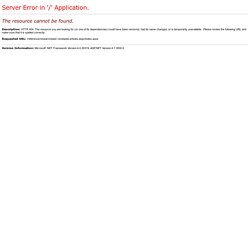
Your instructor has asked you to find an article in a scholarly (or professional or refereed or peer-reviewed) journal. Scholarly journals differ from popular magazines and trade journals/magazines in a number of ways. (See "Comparison Chart" below.) Getting Started on Your Literature Review. Here you can find a short guide and a few suggestions for postgraduate research students on how to get started on a literature review.
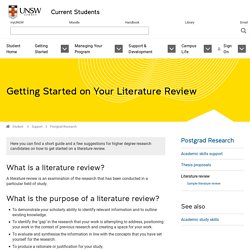
How could I write my literature review? When writing your literature review, it is essential to remember that it will only be completed when your thesis is almost finished, because new research and publications are constantly being produced. At some stage you will have to be happy with what you have and leave it at that; however, you will be continually adding to your review and will probably rewrite it a number of times. It is always invaluable to read the literature reviews in other theses. These will provide possible structural models for your own literature review. Stanford Literature Review. What is it?
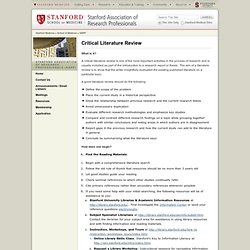
A critical literature review is one of the most important activities in the process of research and is usually included as part of the introduction to a research report or thesis. The aim of a literature review is to show that the writer insightfully evaluated the existing published literature on a particular topic. A good literature review should do the following: Define the scope of the problem Place the current study in a historical perspective Show the relationship between previous research and the current research thesis Avoid unnecessary duplication Evaluate different research methodologies and emphasize key studies Compare and contrast different research findings on a topic while grouping together authors with similar conclusions and noting areas in which authors are in disagreement Report gaps in the previous research and how the current study can add to the literature in general Conclude by summarizing what the literature says How does one begin?
C. Social Work Literature Review Guidelines. Summary: This handout provides an overview of how to write literature reviews in the field of social work.
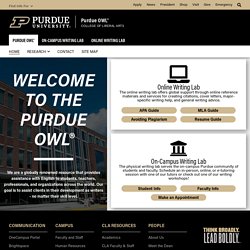
It provides a list of suggestions and examples. Tips for writing your first scientific literature review article. The finished product There were many points at which I felt overwhelmed by the task and didn’t see a clear path to finishing the article on time.

I tried to reassure myself by remembering that I had been rather good at writing term papers in college; but this was a larger task and one with the potential for having an impact on someone, somewhere, sometime who wanted to learn about caspase substrates. In the end, I finished by the deadline (well, plus one two-week extension the editor agreed to grant me) and was very happy with the product and with all I had learned about caspase substrates, about the scientific literature and about the review-writing process. Yet I estimate that the next time I undertake a task like this, I’ll be able to do it in half the time. I hope the following tips will help other scientists who find themselves in this kind of uncharted territory. 1. Emily Crawford (emily.crawford@ucsf.edu) is a graduate student at the University of California, San Francisco. Annotated Bibliographies. Summary: This handout provides information about annotated bibliographies in MLA, APA, and CMS.
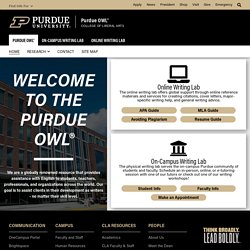
Contributors:Geoff Stacks, Erin Karper, Dana Bisignani, Allen BrizeeLast Edited: 2013-03-10 11:25:28 Definitions A bibliography is a list of sources (books, journals, Web sites, periodicals, etc.) one has used for researching a topic. Bibliographies are sometimes called "References" or "Works Cited" depending on the style format you are using. What is a Review Article? A Guide to Writing the Dissertation Literature Review - v14n13.pdf. Analysis of the structure of original research papers: an aid to writing original papers for publication. Reading and Analyzing Research Papers. Objective: Read a research paper and identify its contributions and limitations. Summarize the paper's contributions and limitations clearly, succinctly, and articulately. You can return to the review later and quickly refresh your memory about what the paper was about.
Reading: What to Look For. How to Write a (Barely) Passing Paper. As someone who had to write a lot (as an undergrad and grad student), please allow me to commend you on your points. I do have a few few additions and nitpicks, though, but allow me to foreword those by saying my MA is in European history, so not everything I say is universal. (Also note that this response will be quite lengthy.) 1. There is, in my experience, always leeway in the question being asked. Even if the question is the most basic "Is Argument X true or false? " 2. 4. 7. 8. 9. 11. Apa-annobib-sixth.pdf. APA Formatting and Style Guide. Summary: APA (American Psychological Association) style is most commonly used to cite sources within the social sciences. This resource, revised according to the 6th edition, second printing of the APA manual, offers examples for the general format of APA research papers, in-text citations, endnotes/footnotes, and the reference page.
For more information, please consult the Publication Manual of the American Psychological Association, (6th ed., 2nd printing). Contributors:Joshua M. Paiz, Elizabeth Angeli, Jodi Wagner, Elena Lawrick, Kristen Moore, Michael Anderson, Lars Soderlund, Allen Brizee, Russell KeckLast Edited: 2013-09-18 10:33:51. "APA Documentation" UW-Madison Writing Center Writer's Handbook. Writing Workshops for Graduate Students. Summary: